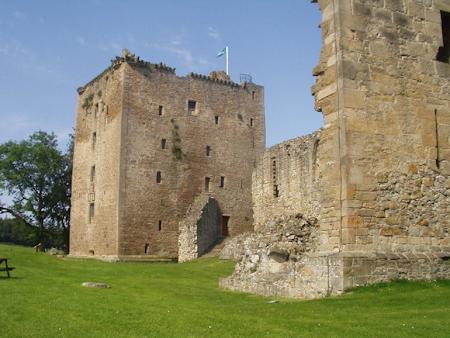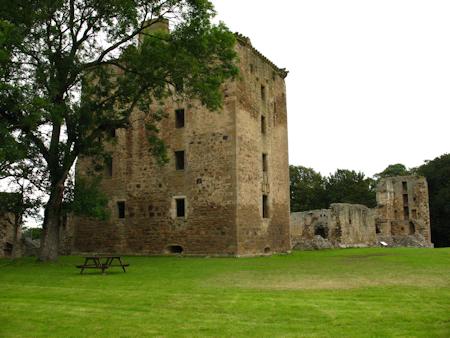
Spynie Palace
Spynie Palace was the fortified seat of the Bishops of Moray. At its height it was one of the finest and most powerful castles in Scotland. It was visited by royalty numerous times. It fell into ruin after the religious upheavals of the 16th and 17th Centuries, but you can still see some of its old power today.
When it was first built Spynie sat on a promontory jutting out into the loch. At this time Loch Spynie was a much larger sea loch and it made a safe anchorage for ships and provided direct communication with southern Scotland.
The Early Castle
The first Bishops of Moray didn't live in one place. They moved between houses at Birnie, Kinneddar and Spynie. It seems to have been Bishop Bricius de Douglas who made the move to Spynie. Pope Innocent III granted permission to move the cathedral and Bishopric seat in 1206.
Subsequent bishops didn't like the cathedral's location. They thought that it was too vulnerable to attack and that it was too far from the market. The cathedral was quickly moved to nearby Elgin where it was defended by the royal castle and could bring in more people. The bishops stayed at Spynie however.
The 12th Century castle was a wooden affair. The buildings were surrounded by a rectangular ringwork and ditch. Inside the enclosure the buildings would have been quite domestic with a bishop's house and hall, a chapel, brewhouse and bakehouse.
In the 13th Century the chapel was constructed. It's likely to have been the first stone building on the site. The fertile farms along Moray's coastline provided considerable revenue to the diocese and the 14th Century saw major stone building work at the castle.
The curtain wall was 7 metres high with an entrance in the south wall. It was covered by flanking fire by a tower in the south-east corner. The main castle building was also constructed in stone during this period.
The defences proved to be very necessary. The rich lands of Moray had long been a tempting target for Highland raiders. In 1390 though, the attack came from the other direction.
Alexander Stewart, Earl of Buchan attacked Moray. He burned the cathedral at Elgin and it seems he took Spynie Castle too. The King ordered him not to enter the castle for any reason.
The death of Bishop Alexander Bur in May 1397 saw the Earl back again. The king appointed him warden of the castle while a new bishop was being appointed. About a year later he was ordered to give it to William de Spynie, Bishop of Moray.
A Powerful Castle
The 15th Century saw more building work at the castle. Bishop John de Winchester was the king's Master of Works. He altered Inverness Castle, Urquhart Castle and upgraded the gatehouse at Spynie. The gate was moved from the south wall to the east and a new gatehouse was built with fine stone carvings and a portcullis.
The later 15th Century saw the addition of David's Tower by Bishop David Stewart. It is one of the largest medieval Scottish towers. Standing 6 storeys high, it has a vaulted basement and a garret on top.
The religious upheavals in the 16th and 17th Centuries had a profound effect on Spynie Castle (which by this time was being called a palace). The Reformation saw the palace being made available to the Crown at short notice.
The Palace's Decline
The palace was given to the Lindsay family from 1587 to 1605. They were worried about a possible Spanish invasion and upgraded the defences.
In 1640 it was back in the hands of the, by now deposed, bishop. The castle was besieged and taken by the Covenanters. The held it for five years until the Marquis of Huntly took it back for the Royalists.
By the end of the 17th Century Spynie Palace was in the hands of the Crown. The iron work and wood carvings were removed and the castle fell into decay. The local people used the stone for their own building projects until the 19th Century.
Land reclamation projects in the 19th Century saw Loch Spynie dramatically reduce in size. With the bishops gone the medieval burgh that grew up around the palace and relied on the bishops for work, also melted away without a trace.
Today Spynie Palace is under the care of Historic Scotland. They run it as a visitor attraction and heritage site. Unfortunately the Great Hall and David's Tower are not accessible, but it is possible to look round the rest of the palace.
The facilities available at the palace include a gift shop, toilets, a picnic area and car parking.
Status: Visitor Attraction / Heritage Site
Owner: Historic Scotland
Tel: +44 (0)1343 546 358
Website: www.historic-scotland.gov.uk
Opening Times: 1st April to 30th September Daily 9.30am-5.30pm


Spynie Palace keep

Spynie Palace viewed from the south east